Born in 1956, the Rolex Milgauss did not follow the same trajectory as the Submariner or the GMT Master. Nonetheless, in its own way, it has become an icon, a toolwatch greatly appreciated by collectors. But then, why has this watch never been unanimously acclaimed? And what makes this Rolex so “different” from the others? We invite you to (re)dive into the history of the atypical Milgauss!
The reasons that pushed Rolex to create the Milgauss
The 1950s were a glorious decade for Rolex. They indeed saw the birth of such iconic models as the Explorer and the Submariner, in 1953, then the GMT-Master in 1955, and the Day-Date in 1956. This same year also marked the launch of a very special watch, the Milgauss.
Here, the watch was not designed for the army, nor even for pilots, but for scientists. Shortly after the end of the Second World War, industrial and scientific demand is strong, and professionals are increasingly exposed to magnetic fields that could affect the precision of their mechanical watches.
Rolex, always on the lookout for significant innovations, rises to the challenge by developing a watch capable of withstanding magnetic fields of up to 1000 gauss (hence its name), a technical feat at the time.

The secret to the Milgauss’ exceptional performance lies in its innovative casing. Rolex has effectively integrated a soft iron cage (dubbed the “Faraday cage”) around the movement, the automatic calibre 1080, thus creating a protective barrier against magnetic influences. This approach, although simple in appearance, was revolutionary for the time and laid the foundation for what could be considered the ultimate scientific watch.
A watch that has always struggled to find its audience
Despite its advancements, the Milgauss did not immediately capture the attention of the general public, remaining a technical curiosity admired mainly by connoisseurs and professionals to whom it was intended. The story even goes that this Rolex was especially appreciated by the scientists at CERN (European Council for Nuclear Research) in Geneva.
Unlike other models from the brand that experienced almost instant commercial success, the Milgauss thus followed a more discreet path. Aesthetically, the first references (6541/6543) are reminiscent of the Submariner of the time, with its unidirectional bezel and Oyster bracelet. But the Milgauss also stands out due to a few more exclusive elements, notably a lightning-bolt-shaped second hand, sword-shaped hands instead of the iconic “Mercedes” hands, and a textured dial with a honeycomb finish.
Starting from 1960, Rolex attempts to give a second wind to its tool watch, by unveiling the reference 1019. More sober and sleek, this new Milgauss benefits from several aesthetic changes, among which a smooth bezel and a thin second hand (gone is the lightning bolt shaped hand!). The dial, available in two variants (black or silver background), offers improved readability and a more versatile style… and less divisive. Technically, however, nothing changes: the Milgauss was designed to withstand magnetic fields and it still does so perfectly.
Not enough to captivate the public though. Even if it remains in the catalog for 28 years, this Rolex hardly sells at all and eventually disappears from the catalog in 1988.

The revival of the Milgauss and the enthusiasm of collectors
If some purists try to give it a second chance on the second-hand market, it is only at Baselworld 2007 that the Milgauss reappears. Indeed, Rolex decides to reinvent it with reference 116400.
This new model, while remaining faithful to the spirit of the original, features modernized design elements, such as green-tinted sapphire glass, a first for Rolex. Now equipped with a 40 mm case (compared to 38 previously), the reference 116400 also receives a new COSC certified caliber 3131, still well protected in its cage.
More modern in style, while respecting its technical and scientific fundamentals, this version of the Milgauss is much better received, finding its place among a wider audience who seem to appreciate both its anti-magnetic capabilities and its unique aesthetic.
With its “Z Blue” version unveiled in 2014, combining a blue dial with its famous “green glass” and the iconic orange lightning-second hand, the Milgauss has confirmed its status as a different kind of watch.



His journey, anything but linear, perfectly illustrates how a watch initially designed for a specific niche can transcend its initial purpose. Despite, or perhaps because of, its unconventional approach, the Milgauss continues to fascinate and inspire. The rare 6541 references available on the second-hand market see their price easily exceeding 100,000 euros while the 1019 exchanges around 30,000 euros.
As for the youngest, the Milgauss 116400, it delights collectors for a budget between 8000 and 10,000 euros. Not bad for a watch that has never achieved unanimity!
💡Also read : Rolex Cellini: why has nobody ever wanted this watch?


